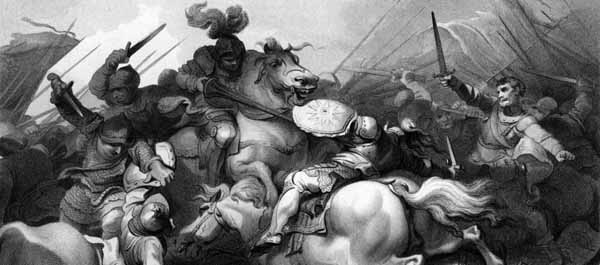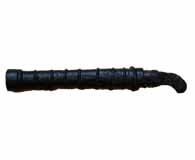The Guns of the Battle of Bosworth, 1485

EDITOR’S NOTE: The November 2012 issue of Armchair General magazine features ACG Board Member and internationally-renowned forensic archaeologist Douglas D. Scott’s article “Battlefield Detective: The Case of the Small Lead Ball.” The diminutive (less than 30mm) lead ball – fired by a small cannon during the 1485 Battle of Bosworth – helped battlefield detectives, at long last, discover the true location of one of history’s most famed battles. In this web article, Scott expands on his ACG magazine article by delving into how the discoveries at the Bosworth battlefield are redefining historians’ knowledge of early gunpowder weapons’ use in medieval warfare.
{default}The August 22, 1485 Battle of Bosworth gave England’s House of Lancaster victory in the War of the Roses (1455-85), displacing the House of York on the English throne. However, until important fieldwork was undertaken in 2009, the decisive battle’s exact location had been lost to history. Yet, the discovery of a small lead ball proved the key to unlocking the secret of where the battle was fought. More fieldwork unearthed other small projectiles from the battle. These finds by battlefield detectives of numerous lead cannon projectiles of widely varying sizes have not only allowed us to finally discover the actual location of the Battle of Bosworth, this evidence provides fascinating new information about the use of early cannon in medieval war. The pattern of distribution of the unearthed three dozen cannon lead projectiles suggests an exchange of artillery fire by both sides.
 The scale of the battle’s initial artillery salvo seems to have influenced the way the Battle of Bosworth was fought, encouraging Henry Tudor’s Lancastrian army to make a flank attack on King Richard III’s York army rather than face a frontal approach under heavy fire. However, these weapons were not yet a battle-winning force. In the main action it was almost certainly through archery and then hand-to-hand fighting, just as at Agincourt (1415) or Crecy (1346), that the battle was won. Not until the Battle of Pinkie Cleugh (fought against Scottish forces near Edinburgh in 1547), would an English army win a decisive victory in a major battle chiefly through the use of firepower.
The scale of the battle’s initial artillery salvo seems to have influenced the way the Battle of Bosworth was fought, encouraging Henry Tudor’s Lancastrian army to make a flank attack on King Richard III’s York army rather than face a frontal approach under heavy fire. However, these weapons were not yet a battle-winning force. In the main action it was almost certainly through archery and then hand-to-hand fighting, just as at Agincourt (1415) or Crecy (1346), that the battle was won. Not until the Battle of Pinkie Cleugh (fought against Scottish forces near Edinburgh in 1547), would an English army win a decisive victory in a major battle chiefly through the use of firepower.
Most of the lead round shot discovered at Bosworth ranges in diameter from less than 30mm up to 94mm, roughly equivalent to the largest mobile field artillery piece in common use in the following centuries. In contrast only two or possibly three lead bullets, likely to have been fired by “hand cannons,” an early type of hand gun with a large bore, have so far been recovered from the site. But this is no surprise. With one or two notable exceptions, such as St. Albans in 1461 where a company of foreign hand gunners were deployed, handheld firearms seem rarely employed by English armies until the mid-16th century. The effectiveness of the English longbow meant that the introduction of the early handgun was not a priority here compared to other parts of Europe.
The later part of the 15th and early-16th centuries was a period of great experimentation and innovation in the technology of gunpowder weapons, something confirmed by the variation in type and size of munitions fired at Bosworth. All the types reported in the documentary sources for the first half of the 16th century are present. Some are of solid lead but most are composite: several have an iron cube at their core, others a large pebble, while yet more contain either small pieces or large chunks of flint, all cast about with lead to make a spherical projectile. The reasons for this are now hotly debated: Was it simply to save lead? Was it an attempt to give the munitions special ballistic properties? Or was it perhaps to reduce their weight because the gun barrels, many of which were made of wrought iron rather than the cast iron or bronze typical of later centuries, simply could not take the pressures that a heavier ball would cause? By the time of the Civil War in the 1640s, composite munitions had long since disappeared, replaced by cast iron, with only some of the smallest artillery pieces still using solid lead munitions. By then the character and battlefield role of gunpowder weapons was well-established and firepower often decided the outcome of battles.
 Determining how many artillery pieces were actually firing at Bosworth, and whether it was fire from both armies, will require more research and experimentation for there is, as yet, no comparative data from any other battlefield. For example, some of the munitions of nearly identical diameter could have been fired from a “ribauldequin,” an artillery piece which could have three or more barrels on a two-wheeled carriage. However, there are so many different diameters of round shot present that there must have been at least ten pieces of artillery and perhaps two hand cannons present.
Determining how many artillery pieces were actually firing at Bosworth, and whether it was fire from both armies, will require more research and experimentation for there is, as yet, no comparative data from any other battlefield. For example, some of the munitions of nearly identical diameter could have been fired from a “ribauldequin,” an artillery piece which could have three or more barrels on a two-wheeled carriage. However, there are so many different diameters of round shot present that there must have been at least ten pieces of artillery and perhaps two hand cannons present.
There are more munitions still to be found as new finds in October 2010 demonstrate; others may have been lost in the small areas now built up by the three farms on the battlefield; and a few more were perhaps retrieved by farmers in former centuries, though no record of this has yet been found. The importance of Bosworth is not that it is the first place where such guns were used in battle. Nor did it see their first large-scale use, for the Swiss captured perhaps as many as 400 when they defeated the Burgundian army at the battles of Grandison and Murton in 1476. Neither was it the guns that won the battle. No, the great excitement of the recent discoveries at Bosworth is that it opens the door on the archaeological study of the origins of firepower. It shows that where sites have not been ravaged by treasure hunters, archaeology may be able to reveal the numbers and sizes of guns, where they were positioned and the intensity of fire they laid down. Work by the team in 2010 on surviving guns in Europe and complemented by firing experiments using reproduction guns, and the application of various techniques of scientific analysis, has shown it may be possible to distinguish whether the gun from which the ball was fired was of the old cast iron type or the new cast bronze guns.
Douglas D. Scott, PhD, is a widely-recognized authority on military archaeology and a frequent commentator in broadcast media. His numerous books include: Archaeological Perspectives on the Battle of the Little Bighorn, A Sharp Little Affair: The Archaeology of the Big Hole Battlefield, They Died With Custer, and Custer’s Heroes: The Little Bighorn Medals of Honor.
AUTHOR’S SPECIAL THANKS: The Bosworth study was undertaken by the Battlefields Trust with funding from the Heritage Lottery Fund and Leicestershire County Council, and continued in 2010-11 thanks to the support of Huddersfield University. Leicestershire County Council initially commissioned the survey to ensure the accuracy of the story presented in their revamped visitor centre on Ambion Hill. Much has since been made of the fact that the center is not located at the site of the battle, but visitor centers should not be placed at the heart of battlefields, or they may damage the very sites they are intended to explain. Redeveloped facilities at Bosworth now give the updated story and provide a gateway to the battlefield, where it is hoped it will soon be possible to develop a new trail which will take visitors to the heart of this important historic site.


this is a good website